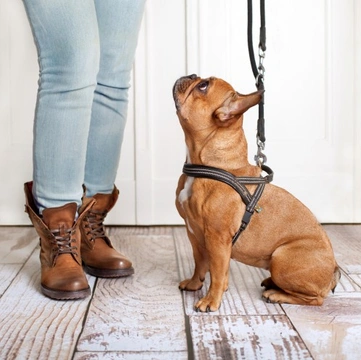
Dealing with a dog that grabs or chews the lead when out walking
Walking the dog is one of the most important parts of dog ownership, and once your dog is trained, this routine should become part of your daily schedule and be a fairly uneventful, straightforward process. However, on the lead walking is not always as simple as it seems, and there are a range of problems and difficulties that can arise when walking your dog, either that have become ingrained from the get-go, or that develop over time. One of the most annoying of these problems is owning a dog that is apt to try to play with their lead, either by grabbing at it when you put it on them or when out walking, or if your dog is determined to hold the lead in their mouths when walking, attempting to chew it.
While this is not one of the worst of all of the potential issues that can arise when walking the dog, it can be a pain in and of itself, as well as proving rather expensive as each new lead becomes progressively more mangled! In this article, we will look at the various ways in which you can address the problem of a dog that is apt to grab at or chew on the lead when walking.
Why is your dog chewing on or grabbing at the lead?
Grabbing at the lead is often a problem that begins to arise when your dog is young, when they begin to associate the lead with going out for a walk. Knowing that they are about to be walked is exciting for most dogs, and if you are not moving fast enough for their liking or they wish to chivvy you along, this may manifest as actually going to fetch the lead themselves, or grabbing at the lead when you reach for it to put it on your dog.
It is important that when this happens, you tell your dog “no” and wait until they are calm to put the lead on them, and do not reinforce their bad habit by simply getting the lead onto them and herding them out of the door as fast as possible.
Some dogs are simply obsessed with holding things in their mouths, and this is most likely to happen with retrieving dog breeds, and other dogs that go mad for a ball or the chance of a game. If your dog has an alternative to hold in their mouths, such as a ball or other toy, this can potentially redirect their behaviour from grabbing at or taking hold of the lead.
Young dogs and puppies, particularly when teething, will often seek to take anything and everything in their mouths, and mouthing and biting at things is one of the main ways in which young dogs explore and learn to understand their world. This is particularly likely to be the case with objects such as the lead, which form an important part of your dog’s life. Particularly if your lead is leather, this type of tough but flexible texture can be very satisfying for the young dog to chew, and so again, diverting them with something else and providing plenty of chew toys for your dog can help with this.
How to stop grabbing and chewing
Just as you would if your dog was taking an interest in something else that they should not have, or begins chewing things that are inappropriate, a combination of good training and diversionary tactics can help to nip chewing and grabbing in the bud.
Never let your dog jump up for their lead, and wait until they are calm before attaching it and leaving the house. When you begin doing this, the problem may at first become more pronounced as your dog becomes progressively more frustrated at your lack of activity, but ultimately, they will learn that they are not going anywhere until they behave, and will calm down eventually as they learn that this is your cue to put them on the lead.
For dogs that like to chew, substituting the lead with a chew toy or other object that is appealing to your dog to hold or chew is a good idea, although you will of course need to keep an eye out for your dog dropping it and losing it once you are out and about!
Using a deterrent spray such as bitter apple on the lead itself can remove the chewing reward from your dog, as the unpalatable taste of it will help to discourage chewing. When the lead is not in use, keep it well out of the way of your dog and ensure that it is not hanging down somewhere that your dog can grab it, and also that it is out of your dog’s line of sight so that it does not catch their eye and prove tempting.



